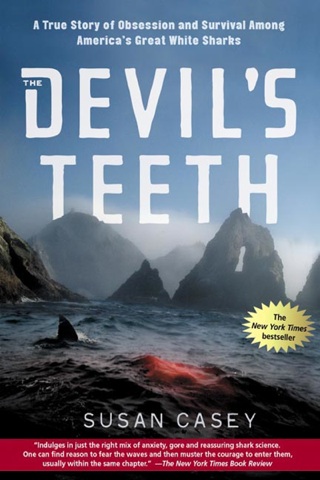
For a visit to the San Francisco Bay Area last weekend, I got caught up in the book “The Devil’s Teeth” about the Farallon Islands and the great white sharks out there, 28 miles from the Golden Gate Bridge. Published in 2005, the book had been knocking around my book shelves for years, a present from my older brother who told me I must read it. Indeed he was right, especially while in the Bay Area where I could stare out to sea, hoping to catch a glimpse of the rocky and remote Farallones on the edge of the vast Pacific.
The Farallones have long been a mysterious and dangerous island chain, where nasty storms and waves could be treacherous. Just last month tragedy struck when five crew members attempting to round the islands were killed during the annual Farallon sailboat race when waves knocked them overboard and washed their boat onto the rocks. Similarly in April 1982, six others died when a storm blasted the Farallon race.
The Farallones are not for the light of heart and only a handful of scientists are granted access to be on the southeastern island, which is a bird sanctuary. It’s a place filled with bird guano and surrounded by waters infested from September to November with great white sharks.
Such is the environment journalist Susan Casey threw herself into, joining biologists Peter Pyle and Scot Anderson on the Farallones to monitor the sharks and their attacks on seals. Her book is heady stuff, as if you can feel these 18-foot predators swimming around you under their small boat. It’s eerie and informative, giving a broad picture of the sharks, how they hunt during the day, chomp on surfboard decoys and are segregated with the larger dominant “Sisters” staying in different areas from the males. It also recounts the unlikely history of the islands where in 1942 more than 100 people from the military and government and their families once lived.
Susan Casey can write the daylights out of nature and science, but it’s her personal anecdotes and adventures of life on the island and in the shark-invested waters with the biologists and a bold sea urchin diver there that are most entertaining and gripping, especially her three-week solo stay anchored on a yacht off the island, which gets truly harrowing when a storm hits. “Even as the place was trying to kill me,” she writes early on, “I had never felt more alive.” Such sentiments capture the island’s hold on those who work and return there every year — to a place, she writes, where “only wild things came.”
In the end the price she pays to get the story amid increasing managerial restrictions on the island and others pay to continue their shark pursuits is very high. Heads roll, for sure, but luckily all get through alive. The fallout is heavy though and leaves one wanting to know more about what happened to all in the aftermath. As for the sharks, hopefully they’ll continue to come back to the Farallones and be studied for many more decades to come.
“The Devil’s Teeth” definitely made me want to read Susan Casey’s latest book “The Wave: In Pursuit of the Rogues, Freaks, and Giants of the Ocean” somewhere down the line — as she is a writer who combines science and adventure in a truly intriguing and informative way.
